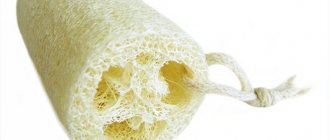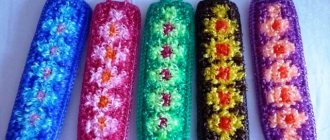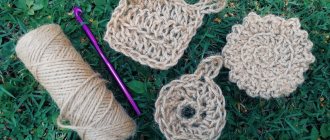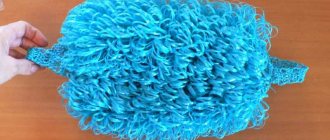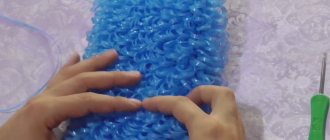A little history and purpose
It is not known for certain when the first devices appeared to help cleanse the skin, but already in references in Babylon and Ancient Greece there is information about the first washcloths. Wealthy people used wood or bronze to wash their skin, while poor people used bunches of plants or sand.
Now, a washcloth is already an absolutely necessary household item for every person. Beautifully designed, of different sizes, colors and purposes, they decorate the bathroom and are indispensable assistants in the bathroom.
A washcloth can be made from any available material: natural cotton or chintz, using old terry towels, woven from burlap, and for those who are not looking for easy ways - knitted.
Kese washcloth
This washcloth is designed to remove dirt from the skin without the use of scrubs and cleansing gels. If a person has sensitive skin, it is made from natural fibers, silk; for coarser skin, it is made from sheep or goat wool.
Its homeland is the East; from ancient times to this day it has been woven in the traditional way - crocheted. First, you need to knit a handle of 40 loops with two threads, on the third, start knitting cap stitches to the end of the chain - the first handle is ready, we make the second in the same way and fasten its end to the first.
The main part of the washcloth consists of three stitches of 16 single crochets, connected to three stitches of 16 double crochets. The washcloth is ready!
It must be thoroughly washed with water and wrung out well to avoid the appearance of various bacteria and unpleasant odors, since the material used in the base does not dry well and retains moisture for a long time.
Burlap washcloth
If you don’t know how to knit or don’t want to, you can make a beautiful washcloth with your own hands using burlap, for this you will need: burlap, foam rubber or sponge, gauze, soap and elastic, and also a piece of cotton fabric.
From burlap you need to cut two identical rectangles slightly larger than your palm, and the same ones for the gauze lining. A holder for a bath accessory is made using an elastic band, assembled like an accordion and covered with fabric. One end is secured in the middle of a burlap rectangle, and the other is sewn to the side.
Next, the burlap is sewn together to form a bag and pieces of soap and a sponge are placed in it to create foam; dried lavender or mint can be added for scent. The washcloth needs to be sewn up. It is ready to use. When the soap in it stops foaming, you will need to rip it open and pour in a new portion.
How to make macrame correctly using weaving patterns
Introduction to macrame weaving patterns for beginners
You can weave not only panels and hammocks using the knot weaving technique. Craftswomen create earrings, necklaces, belts and lace to decorate clothing items.
First you need to decide on the quality of the threads for weaving and take into account several nuances:
- It is better for beginners to practice on cords of different colors;
- for work you need to choose threads with a round cross-section;
- synthetic threads are too slippery and difficult to fold into a beautiful knot;
- wool threads should be thick and well twisted;
- To prevent the threads from unraveling during work, you need to tie them at the ends into knots or melt them over a fire;
- weaving from rigid ropes will become easier if you wear thin knitted gloves;
- threads with noticeable pile are woven easier if you wet your palms with water from time to time.
To work, you will need a board or a book in landscape format. Some craftswomen attach threads to a special tube or rod of small diameter. But weaving knots in a canopy requires some preparation.
Preparation before work:
- Place the board in front of you with the wide side down.
- Make a loop out of the thread and wrap it around the board parallel to the floor (the knot should be on the reverse side). This thread will act as a bar on which you attach the working threads.
- Each knot has working and knotting threads. Knotted threads should be 5-7 times longer than working threads.
- Cut the required number of threads, fold them in half and fasten them as shown in the diagram.
Now you can weave the first training knots on this blank.
Macrame weaving knots and patterns for beginners
The square flat knot is the most popular element in the knot weaving technique. Macrame bracelets are woven using square knots.
A single flat knot consists of one loop. How to do this can be seen in the diagram.
A double flat knot is used for weaving floss baubles or other types of threads. Pay attention to the weaving sequence: each next knot should be a mirror image of the previous one. Otherwise, the resulting flat thread will begin to twist in a spiral.
From square knots you can weave a rhombus, as shown in the diagram.
The number of nodes is measured in tens. We will look at basic techniques with corresponding diagrams.
Knot chain.
Chameleon knot.
Tatting knot.
In the diagram you can consider and try other, no less beautiful techniques for creating knots.
Schemes for weaving panels on the wall using the macrame technique (with step-by-step photos)
A wall panel is a great opportunity not only to practice weaving techniques, but also an opportunity to create an original piece for your interior with your own hands.
For the panel you will need:
- 10 threads, 5 m each; scissors;
- wooden plank 45-50 cm long (it will become part of the future panel).
Operating procedure:
- fold each thread in half and secure it to the bar;
- distribute the threads so that the distance between them is the same (about 7-8 cm);
- from 1 and 2 threads weave a double flat knot in 3 passes;
- perform a similar operation with each subsequent pair of threads;
- separate 2 threads from the first knot (those that are closer to the center) and 2 threads from the second knot;
- weave a double flat knot from them in 3 passes and perform a similar operation with each subsequent pair of threads;
- repeat step No. 3 and secure the threads with knots located diagonally.
diversify your home decor and create original decorations with the help of “beaded flowers.”
How to weave a macrame belt (master class for beginners)
To work you will need:
- beautiful buckle with cross fastening for threads:
- silk or synthetic threads – 3 pcs. 10 m each;
- scissors.
Operating procedure:
- first you need to master weaving a double flat knot with a central thread (you can choose a different color for the central thread);
- attach the threads to the buckle as shown in the picture;
- weave until you get a belt of the desired length;
- to finish weaving, use the “diagonal bead roller” knot, as shown in the diagram;
Using this technique you can weave a watch strap.
Pattern for weaving macrame for flower pots (step by step for beginners)
DIY weaving patterns for macrame flower pots are varied and popular among craftswomen. Some people weave flowerpots from the top edge, others start weaving from the bottom. Let's look at simple schemes for beginners.
For work and training, you can use threads cut from old colored T-shirts . How to make such yarn can be seen in the photo.
Scheme for weaving flower pots from below:
To work you will need:
- 8 thread blanks, 2-3 m each (depending on the height at which you plan to hang the pot);
- a flower pot; scissors.
Operating procedure:
- Connect the ends of the blanks and tie one common knot. The resulting brush will be located at the bottom of the pot and will serve as an additional decoration.
- Separate the first and second threads and tie 1 flat knot at a distance of 5 cm from the main one.
- Connect all the other threads of the workpiece in pairs. As a result, you will have 4 nodes.
- Separate 2 strands from adjacent knots and tie them into a double flat knot.
- Repeat the operation with other threads so that adjacent nodes are connected in pairs.
- Repeat step 2 and check how securely the pot fits inside the finished planter.
Using the same pattern, you can weave a flowerpot, starting from the top. To do this, you will additionally need a ring for attaching threads. The lower part can be tied with a common knot and a second tier can be made for the second pot.
Here are some examples of interior design using simple flowerpots.
If you have a ready-made flowerpot, but no fresh flowers, you can make beaded trees with your own hands.
Stylish macrame jewelry
Knots can be used to create many practical and sophisticated things. Designer jewelry is highly valued, and the abundance of blanks for jewelry and decorative elements in handicraft stores will allow you to create original pendants and earrings. Original beaded bracelets will be a worthy addition to the set.
To begin with, you can practice on simple patterns and weave, for example, a keychain. For additional decoration you will need large beads, a key ring and multi-colored cords . How to do this can be seen in the diagram.
Handicraft stores are a separate universe, once in which it is no longer possible to leave without buying something. -Beaded brooches look exquisite and elegant, because no one else in the world will have these.
Pendants and necklaces can be made from any available materials. Lace, multi-colored threads and cords, multi-colored beads and openwork decorations are used. The operating procedure and diagram can be seen in the photo.
Mesh washcloth
A washcloth can also be constructed from a mesh, which can be purchased in any bathroom department of a large hardware supermarket or at a bazaar.
To do this, you need to form a bag out of it, insert pre-cut foam rubber and fix it on top. The sponge will create a thick foam that can cleanse pores and give freshness to the skin.
Polypropylene washcloth
To knit such a bath “helper”, it is enough to purchase the appropriate threads and a hook size 5-6 with a round head. Initially, you need to knit a chain of loops 20 cm long and connect them into a ring.
Next, you need to knit the main fluffy part of the washcloth using the “DC” method and finish with several rows of “SC”, and at the end knit the handles. This way you can knit a washcloth from any material.
What you might need for work
Before you start making a washcloth, you need to get supplies. There are very few of them.
You will need:
- Six grids;
- Strong rope.
You will also need scissors.
Results
If you look at examples of photos of do-it-yourself washcloths in books, brochures, craft magazines or on the Internet, you will see what a variety of these bath items there are. In addition to the original accessory, spending a minimum of time and effort, you will receive a real decoration for the bathroom, an indispensable cleanser suitable for your skin and save money.
Such washcloths can be given as a gift or an addition to a gift, or they can also be sewn for children in the form of various animals or cartoon characters. The child will be more willing to bathe with such a gift.
Synthetic
A variety of materials are used to make synthetic washcloths: foam rubber, rubber, polyethylene, etc. They differ in appearance, shape and size. Thanks to the wide range, you can choose a synthetic washcloth for both adults and children.
The advantages of artificial materials include:
- Wide choice in terms of hardness . You can choose an option for any skin type, including those with a large number of moles or skin diseases.
- Long service life . Such a washcloth can last more than a year without losing its quality and appearance.
- Hypoallergenic . High quality artificial materials do not cause allergies.
- Resistant to the formation of fungi, mold , etc.
Abundant foaming . Synthetic materials foam soap well and produce thick and abundant foam, which is very important for quality cleansing.
The disadvantages include:
- High cost.
- Minimal resistance to high temperatures (they may become deformed if they are constantly in the bathhouse).
In general, synthetic washcloths are not inferior to their natural counterparts. Today, manufacturers offer a wide range of products for daily use, as well as high-quality massage.
Foam rubber
Foam sponges have a soft and pleasant texture. Such products are often purchased for children, as well as people with hypersensitive skin.
The advantages of foam rubber include:
- high foaming;
- the ability to give any shape;
- resistance to the formation of fungi and mold;
- quick drying.
However, it is worth considering that foam rubber quickly loses its shape and begins to crumble. That is why you will have to change such a washcloth much more often than its analogues.
Polyethylene
Polyethylene washcloths are the cheapest. Most often they are made in the form of elongated rectangles with handles. These products come in a variety of colors. Due to their increased rigidity, they are most often purchased by men. Such products are absolutely not suitable for children and sensitive skin.
The advantages of polyethylene washcloths include:
- quick drying;
- resistance to the formation of fungus and mold;
- long service life;
- abundant foaming.
Another budget option. Such products most often have the appearance of a lush rose.
The advantages of these washcloths include:
- hypoallergenic;
- abundant foaming;
- softness;
- resistance to the formation of fungus and mold;
- quick drying.
Products made from nylon or nylon are often purchased for small children. Due to its increased softness, you should not expect deep cleansing from such a washcloth. But, this is an excellent option for daily use. The most important disadvantage of such products is their shape: as a result of frequent use, they quickly become untied and acquire an untidy appearance.
